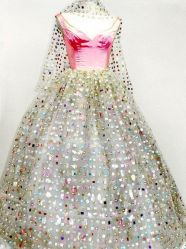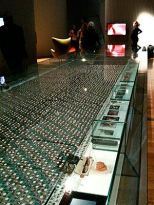As I have prepared for assessment I have spent considerable time checking all my tutor feedbacks, watching recommended videos again and reviewing my samples along with re-working a couple in accordance with my tutor’s suggestions and adding a couple of new ones. During this period of reflection and re-working I came to the realisation that despite my best efforts I had still been too literal in my approach to my theme and that caused restrictions in my creativity – once I am set on an idea I do find it very hard to alter my mindset and this is clearly one of my Asperger quirks (which I am finding somewhat infuriating at present due to my self-awareness of it).
I decided to look again at the theme after reviewing the tutor feedback for Assignment 4 and in particular re-watching a video of Alexander McQueen’s 2017 collection as mentioned in my blog which can be seen at: https://janemurdockmytextilesjourney.wordpress.com/2017/09/16/1328/ which is entitled “Response to research suggestion in tutor feedback for Assignment 4”.
I felt that it would be prudent to work a small selection of samples which could be the basis of a variety of textile projects – they could form part of an interior design piece, clothing or period costume, or accessories as examples or they could be developed further to create the whole piece as part of collection … here I take direct inspiration from how Alexander McQueen’s designers took inspiration from a variety of sources and used individual elements in small or larger forms in the design process.
 I decided to go back to my sketchbook whilst looking at my original sets of samples and collection of photographs for specific elements that I really liked or inspired me.
I decided to go back to my sketchbook whilst looking at my original sets of samples and collection of photographs for specific elements that I really liked or inspired me.
I absolutely love the lacy style fungi which inspired me to use free-motion stitching and water-soluble fabric to create a rough ‘lace’ style ‘fabric’ which can be as loose or dense as I require and this was something I really felt would be appropriate to take forward.
During the reflective process and sketchbook work I was really looking at how I could re-create some of the different textures and linear qualities of the decaying trees and fungi that so capture my attention whilst moving away from a reliance on needle-felting and fabric Suffolk puffs which I had begun to feel were almost a safe option although they do still work well with my narrative.
I also wanted to consider how I could combine the ‘lace’ with linen or calico to create new ‘fabrics’ – the ‘lace’ could take on the appearance of a semi-opaque panel whilst being reminiscent of the lichen and fungi that cover the decaying logs or grow in crevices.
 A Facebook group post demonstrated how to make crocheted yoyo puffs – similar to fabric Suffolk puffs. I had never attempted making these crocheted puffs before but felt that the result was reminiscent of the underside of toadstools or mushrooms. I felt I could potentially use these puffs in groups or individually taking inspiration from the work of the photographer Jill Bliss – they could be a small detail on a pocket or form part of a larger grouping on a panel or cushion. One of my sketches suggests a needle-felted base with free-motion stitched ‘lace’ overlay and topped with the puffs but when it came to working a sample I decided against the base of wool roving – I felt that I would be going back to throwing everything at the sample rather than the more restrained feel I am aiming for in this collection.
A Facebook group post demonstrated how to make crocheted yoyo puffs – similar to fabric Suffolk puffs. I had never attempted making these crocheted puffs before but felt that the result was reminiscent of the underside of toadstools or mushrooms. I felt I could potentially use these puffs in groups or individually taking inspiration from the work of the photographer Jill Bliss – they could be a small detail on a pocket or form part of a larger grouping on a panel or cushion. One of my sketches suggests a needle-felted base with free-motion stitched ‘lace’ overlay and topped with the puffs but when it came to working a sample I decided against the base of wool roving – I felt that I would be going back to throwing everything at the sample rather than the more restrained feel I am aiming for in this collection.
I have noted the possibility of using these crocheted puffs in three-dimensional forms and this is something to bear in mind for the future – could I effectively use the puffs to create yarn ‘sculptures’?
I also noted an idea of using a blanket stitch edge to be able to add a crocheted detail to fabric – this could be in the form of a semi-circular design or simply a border or insert … again something to consider.
 The next page of my sketchbook worked through some ideas regarding creating textures reminiscent of the decaying logs – could I use tucks, couched yarns or distressing or even back and forward post stitched crochet? however I decided to hold back on the crochet for the time being but there is definitely potential with this style of stitch. I confess to finding distressing fabrics quite difficult – the quilter and dress maker in me still does not like rough edges despite loving the theme of decay and hence there is an internal battle for me still which the decay will win eventually! However due to this battle I have considered how I can create a distressed look with using Inktense pencils or fabric paint and either tearing into strips or cutting into the chosen fabric or in the case of hessian pulling through the threads.
The next page of my sketchbook worked through some ideas regarding creating textures reminiscent of the decaying logs – could I use tucks, couched yarns or distressing or even back and forward post stitched crochet? however I decided to hold back on the crochet for the time being but there is definitely potential with this style of stitch. I confess to finding distressing fabrics quite difficult – the quilter and dress maker in me still does not like rough edges despite loving the theme of decay and hence there is an internal battle for me still which the decay will win eventually! However due to this battle I have considered how I can create a distressed look with using Inktense pencils or fabric paint and either tearing into strips or cutting into the chosen fabric or in the case of hessian pulling through the threads.
My sketchbook work seems quite short and basic for this collection of samples and in essence it was really getting ideas out of my head and on paper that I knew some of which I wanted to go forward with – in effect it was a development of the concepts from the rest of the assignment with a large influence of the tutor report and the aforesaid re-watched recommended videos.
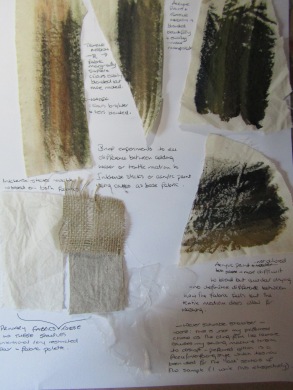 Before I started work on the samples I did a some small test patches of Inktense sticks and acrylics on calico – with the sticks I used them directly on to the fabric with either a water wash or textile medium wash over the top and for the acrylic paint it was either used undiluted or with the addition of the textile medium.
Before I started work on the samples I did a some small test patches of Inktense sticks and acrylics on calico – with the sticks I used them directly on to the fabric with either a water wash or textile medium wash over the top and for the acrylic paint it was either used undiluted or with the addition of the textile medium.
I do like the addition of textile medium to both the sticks and the acrylic paint as it makes it easier to blend the colours and also created a slightly more muted and toned down appearance.
I also added to this page of my sketchbook small samples of the hessian, calico and linen I decided to use and also a left over scrap of the water-soluble stabilizer – the latter is not my chosen one as it has a cling film like feel and it causes my sewing machine tension to go haywire. I much prefer a stabilizer that has the feel of a fine interfacing but my scrap promptly went missing before I could add it to the sketchbook although I did use it primarily for the samples.
So now on to the samples! My intention with them all was to create a pared back collection in comparison to my original set – I wanted to be restrained in terms of fabric palette, colour and design whilst still creating samples that are directly reminiscent of my theme but with no direct textile project specifically in mind which could restrict my creativity.
 1. This sample is the one of two that I felt worked from the start. I painted calico with the Inktense sticks and textile medium and once dry tore it and some linen into strips before weaving them both with some cut hessian strips. I decided to add two sections of the above mentioned ‘lace’ to create the impression of lichen or fungi with the woven section being reminiscent of decaying logs. To hold the weaving in place I minimally stitched down the weft strips with the thread adding a further subtle linear element whilst also serving to hold the whole piece together.
1. This sample is the one of two that I felt worked from the start. I painted calico with the Inktense sticks and textile medium and once dry tore it and some linen into strips before weaving them both with some cut hessian strips. I decided to add two sections of the above mentioned ‘lace’ to create the impression of lichen or fungi with the woven section being reminiscent of decaying logs. To hold the weaving in place I minimally stitched down the weft strips with the thread adding a further subtle linear element whilst also serving to hold the whole piece together.
I am happy with this sample – it has not felt that it has needed altering and it does what it set out to do.
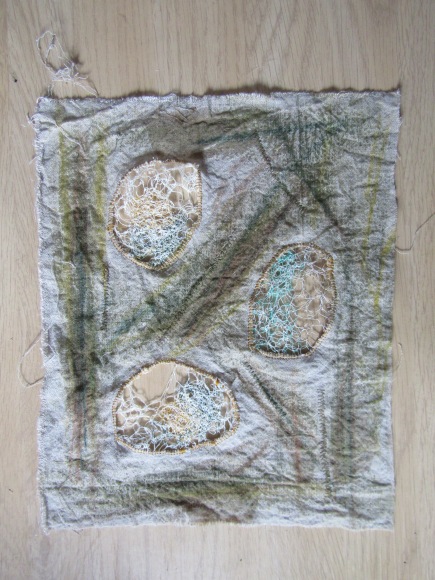 2. This sample was worked directly from an idea in my sketchbook with ‘lace’ inserts being added to a linen background. I machine stitched around the outside of the inserts with a blanket stitch before colouring using Inktense sticks the background (again with the addition of textile medium). Once dry I cut slashes into different areas before finally zig-zag stitching the cuts closed. I wanted this piece to look worn or even muddy as if the cloth had been left in a decaying building or even a fallen branch. The ‘lace’ lichen I feel create both texture and interest in the fact they are almost transparent so whatever this sample is placed upon the background can be seen through it.
2. This sample was worked directly from an idea in my sketchbook with ‘lace’ inserts being added to a linen background. I machine stitched around the outside of the inserts with a blanket stitch before colouring using Inktense sticks the background (again with the addition of textile medium). Once dry I cut slashes into different areas before finally zig-zag stitching the cuts closed. I wanted this piece to look worn or even muddy as if the cloth had been left in a decaying building or even a fallen branch. The ‘lace’ lichen I feel create both texture and interest in the fact they are almost transparent so whatever this sample is placed upon the background can be seen through it.
 3. The third sample I used purely hessian for. I have loved seeing crevices and gaps in fallen branches or tree trunks over the course of this year and am intrigued by the lichen or fungi that grow through them – the organisms appear to be knitting two edges together whilst still continuing the process of decay and this sample reflects this. I have used a simple combination of pulled threads woven through with yarns, sewing-machine made ‘lace’ and also crochet – the lace and crochet stitch their adjoining edges together. I have left the hessian edges rough with some threads being caught in the machine stitched edge of the ‘lace’ – the piece feels that it has a narrative of times gone by and could be perceived to be a scrap of fabric from an old garment so takes on a different concept of decay.
3. The third sample I used purely hessian for. I have loved seeing crevices and gaps in fallen branches or tree trunks over the course of this year and am intrigued by the lichen or fungi that grow through them – the organisms appear to be knitting two edges together whilst still continuing the process of decay and this sample reflects this. I have used a simple combination of pulled threads woven through with yarns, sewing-machine made ‘lace’ and also crochet – the lace and crochet stitch their adjoining edges together. I have left the hessian edges rough with some threads being caught in the machine stitched edge of the ‘lace’ – the piece feels that it has a narrative of times gone by and could be perceived to be a scrap of fabric from an old garment so takes on a different concept of decay.
 4. For this sample I wanted to try working with a combination of the crocheted yoyo puffs, that directly represent fungi, couched yarns that represent the linear qualities of decaying logs and also a small section of ‘lace’. This is one of the samples that I really wanted to be very restrained whilst still with a strong design element – I spent considerable time trying different combinations or arrangements as I thought seriously about the composition. Originally the sample did not have the small circular ‘lace’ panel which is placed between the puffs but when I looked at the sample with an towards critical reflection I felt that something was missing – this is where posting in Facebook groups really helps so that you can get the feedback of fellow students with one pointing out that this sample and a couple of the others did not feel the puffs or ‘lace’ were grounded to the background and that they appeared to be floating. I did agree with the student in their observation although I often feel that when you see fungi, particularly mushrooms or toadstools, from above they can indeed appear to be floating when you cannot see their stem. I decided to add the small ‘lace’ panel between the fungi as it does pick up on the yellow and green yarns used for two of the fungi plus the same yarns that were used for some of the couched areas plus the yellow and cream threads of the longer ‘lace’ panel – in adding this small element I now feel the different elements work in harmony with each other and there is balance in the composition whilst still retaining the contrasts that I desired.
4. For this sample I wanted to try working with a combination of the crocheted yoyo puffs, that directly represent fungi, couched yarns that represent the linear qualities of decaying logs and also a small section of ‘lace’. This is one of the samples that I really wanted to be very restrained whilst still with a strong design element – I spent considerable time trying different combinations or arrangements as I thought seriously about the composition. Originally the sample did not have the small circular ‘lace’ panel which is placed between the puffs but when I looked at the sample with an towards critical reflection I felt that something was missing – this is where posting in Facebook groups really helps so that you can get the feedback of fellow students with one pointing out that this sample and a couple of the others did not feel the puffs or ‘lace’ were grounded to the background and that they appeared to be floating. I did agree with the student in their observation although I often feel that when you see fungi, particularly mushrooms or toadstools, from above they can indeed appear to be floating when you cannot see their stem. I decided to add the small ‘lace’ panel between the fungi as it does pick up on the yellow and green yarns used for two of the fungi plus the same yarns that were used for some of the couched areas plus the yellow and cream threads of the longer ‘lace’ panel – in adding this small element I now feel the different elements work in harmony with each other and there is balance in the composition whilst still retaining the contrasts that I desired.
 5. The second sample using the crocheted puffs proved trickier with regards to composition – I wanted to create a piece that used some calico with I had machine stitched tucks into in combination with patches of the linen and hessian as I was thinking directly of a gown in the 2017 Alexander McQueen collection that was made of stitched patches of fabrics. Initially I added the puffs along with the longer ‘lace’ panel but this was one of the pieces my fellow student felt was not grounded to the background – the addition of the smaller circular ‘lace’ panel I felt resolved the issue whilst connect the colours of the yarns, threads and fabrics together. I did try adding some needle-felting in a variety of different areas in an attempt to further harmonize the piece but in the end removed it because the simplicity and restraint I was looking for was lost – I was on the point of over-egging the pudding again which I had been guilty of in a couple my original samples before re-working.
5. The second sample using the crocheted puffs proved trickier with regards to composition – I wanted to create a piece that used some calico with I had machine stitched tucks into in combination with patches of the linen and hessian as I was thinking directly of a gown in the 2017 Alexander McQueen collection that was made of stitched patches of fabrics. Initially I added the puffs along with the longer ‘lace’ panel but this was one of the pieces my fellow student felt was not grounded to the background – the addition of the smaller circular ‘lace’ panel I felt resolved the issue whilst connect the colours of the yarns, threads and fabrics together. I did try adding some needle-felting in a variety of different areas in an attempt to further harmonize the piece but in the end removed it because the simplicity and restraint I was looking for was lost – I was on the point of over-egging the pudding again which I had been guilty of in a couple my original samples before re-working.
 6. This final sample was a second variation using the tucked calico with the linen and hessian patches. I really liked using the couched yarns combined with the ‘lace’ panels – the yarns and tucks really represent the linear qualities of bark and decaying logs as they decay with the ‘lace’ still being reminiscent of the lichen and fungi. I feel this sample has an almost architectural quality about it and I wonder if my love of architecture is creeping through here subconsciously as an influence.
6. This final sample was a second variation using the tucked calico with the linen and hessian patches. I really liked using the couched yarns combined with the ‘lace’ panels – the yarns and tucks really represent the linear qualities of bark and decaying logs as they decay with the ‘lace’ still being reminiscent of the lichen and fungi. I feel this sample has an almost architectural quality about it and I wonder if my love of architecture is creeping through here subconsciously as an influence.
At this point I feel a short critical review and reflection is needed regarding these samples and in comparison with the original samples for this theme:
Overall these samples I do feel have a stronger and more coherent appearance than my original set although both the colour palette, fabrics and composition are more restrained. I have felt more comfortable and confident really pulling back my designs with a less is more approach – instead of thinking ‘what can I add?’ to make a sample better I have instead asked ‘what can I take away?’. I have used my camera considerably to photograph various arrangements of elements before settling on the final one – this has the effect of enabling me to step back and look with a critical eye and it is a technique I will continue to use. The samples I am most pleased with are the first four – the latter two I am unsure as to whether I have added too much in terms of couched yarns or too little in terms of what I have left out but I know this is something that will come with further experience.
I note I have taken considerable influence from contemporary artists such as as Jill Bliss and Valerie Gardiner but can also see a subconscious influence of abstract or expressionist artists such as Wassily Kandinksy who I have studied in my art history module – the influence of the latter I feel can be seen strongly in samples 4 and 6 in particular and this I am happy about as it proves to me my studies and passion for art history is coming through my work and that is something I desperately wanted.
Am I happy with the restrained colour palette as opposed to the colours used in my original samples? both have their appeals but the restrained palette has, for me, demonstrated the theme in a much stronger way with the colours directly reflecting the decay of the logs and details of the fungi and lichen. The original palette I now feel is more reflective of the moss and fauna that surrounds the decay although has elements of some of the fungi which of course come in such a wide variety of colours and textures. Am I happy with the textural or linear elements of this new set of samples in comparison with the original samples? again I feel this new collection is stronger with the simple contrasting textures of the fabrics and yarns working in harmony to create a unifying appearance to the collection whilst also demonstrating the variety of textures found in a decaying woodland.
Overall I feel that I have worked with my chosen materials in a sympathetic manner to produce samples that communicate my theme across both sets of samples – I should say all 3 sets (one is my original tutor assessed set, the second the reworked versions plus new samples and the third this final collection). I have worked through this last collection with a mind to the working methodology – through the use of my camera I was able to critically review each sample as I worked and this method of developing through direct experimentation does seem to suit me and is therefore something I will take forward. The working methodology of concept, practical response, critical reflection, synthesis/refinement is now without question part of my psyche and one that now feels natural.
As I reflect on the samples I have done I am considerably happier to have done this last set as it is showing how my work is developing and taken the theme that next step further so that it can be used in a variety of textile projects as mentioned above. I would still like to develop the idea of the Medieval bracers as an ongoing project but will be curious to see how the Beauty from Decay theme as a whole develops further throughout my studies.
The one area I had doubts upon was the development of my personal voice and it seems to be taking two parallel but contrasting paths – one a love of colour and detail and the second a calmer, restrained and pulled back appearance and I do feel these different paths are ones I wish to develop … two different personal voices which are two halves of myself.
My weak area is still regarding working on different scales and this is something I really need to work on – I am lacking in a little confidence I feel here but understand this come. Part of my reasons for working on these samples has also been to work on a secondary weak area which is transferring my ideas in my sketchbooks to my working textile samples and I do feel I have benefited from this additional work – by not trying to over-work or over-complicate I feel this set of samples is stronger and more defined.
So my samples are done – I have 3 sets of samples which portray the same theme in two different ways demonstrating different thought processes, techniques and concepts.
Finally a brief note of the criteria for the course:
Demonstration of technical and visual skills: I feel more confident that I have demonstrated a development of materials, techniques, observational skills and visual awareness also vitally for me a development of my compositional skills which I feel has been a weaker area. I do feel that these technical and visual skills can be seen in all the work from Assignment 5 but for me personally particularly in this final set of samples. I want to continue to develop my compositional skills further and have made notes to ensure I pay close attention to this area going forward.
Quality of outcome: I feel I have been able to apply the knowledge I have gained and work in a coherent manner throughout this course and have learnt to judge my work in a more considered manner – my critical reflection skills were previously a weaker area and I feel more confident in my ability in this area now and will continue to work to improve. I also feel now that I am able to conceptualise my thoughts considerably better and communicate my ideas through a combination of my learning log, sketchbooks and textile work – I have often included the critical reflections in my sketchbooks in order that they make sense to me or a viewer when combined with samples without necessarily the need to be able to view my learning log which is obviously very comprehensive. I feel considerably more confident in the quality of my work overall and feel this has developed enormously throughout the duration of this course.
Demonstration of creativity: I have felt more confident working in my sketchbooks where I have been able to communicate my imagination, experimentation and invention and although I have experienced some difficulty in transferring these aspects to my ‘made’ textile work I now feel I am beginning to do so particularly in the last set of samples. My personal voice is starting to develop – I feel I am developing two different paths that will run parallel to one another.
Context: this is where I feel my strength lies in research, critical thinking and reflection and I have developed considerably throughout the duration of the course although I still need to be focused in my notes and written work.

 This is a completely new sample which takes inspiration from the work of Billy Kidd in terms of the black background. I wanted to give an impression of the striped colours of a decaying log with fungi growing over and near by – the fungi are worked so that the centres are much thicker and have a slightly more three dimensional appearance. The coloured rings are reminiscent of the actual coloured rings I have seen on various fungi – I love the fact that the colours do not blend on these fungi but are separate and distinct with the outer edges being the strongest darkest hue and I really wanted to capture that appearance. As I look at the colours I now question whether in August I was looking ahead to the approaching autumn.
This is a completely new sample which takes inspiration from the work of Billy Kidd in terms of the black background. I wanted to give an impression of the striped colours of a decaying log with fungi growing over and near by – the fungi are worked so that the centres are much thicker and have a slightly more three dimensional appearance. The coloured rings are reminiscent of the actual coloured rings I have seen on various fungi – I love the fact that the colours do not blend on these fungi but are separate and distinct with the outer edges being the strongest darkest hue and I really wanted to capture that appearance. As I look at the colours I now question whether in August I was looking ahead to the approaching autumn. The second sample is a re-worked version of my original piece that included Suffolk puffs.
The second sample is a re-worked version of my original piece that included Suffolk puffs.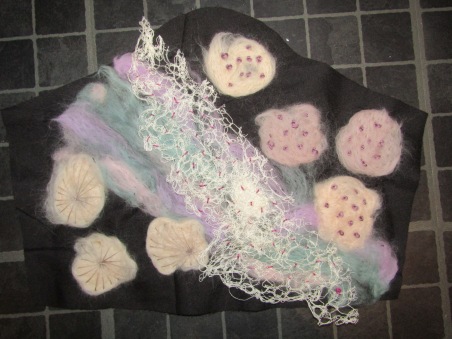 The next sample is the second new one and again took inspiration from the work of Billy Kidd with the black backgrounds and also the work of Lindsay Taylor but also took note of an early thought on changing my colour palette.
The next sample is the second new one and again took inspiration from the work of Billy Kidd with the black backgrounds and also the work of Lindsay Taylor but also took note of an early thought on changing my colour palette. The second piece that my tutor again lacked the sensitivity and design that the first two samples had is this one – this is a re-worked piece from my original collection.
The second piece that my tutor again lacked the sensitivity and design that the first two samples had is this one – this is a re-worked piece from my original collection. Finally the wrapped sample – this was initially an idea that never made it out of the sketchbook as I hated it! However my tutor felt that sample in the sketchbook had real potential …. wrapping is still something I do not quite ‘get’ although I appreciate how it can be used too.
Finally the wrapped sample – this was initially an idea that never made it out of the sketchbook as I hated it! However my tutor felt that sample in the sketchbook had real potential …. wrapping is still something I do not quite ‘get’ although I appreciate how it can be used too. With this sample I removed the crochet edges as planned and in the process of removing the ‘lace’ realised and remembered I had threaded an ochre coloured yarn through it and pulled on it accidentally which resulted in the heavier stitched areas gathering – some accidents have happy results! I played around with this lace for a period of time trying out differing placements and finally settled on one seen in the photo – the off-white thread picks up on the lighter areas of the background and creates a more harmonious feel whilst the darker colours of the background now appear to recede and create depth to this sample as they emphasize the illusion of textures which represent the decaying logs. In addition. I decided to add some free form crochet to one edge of the lace to add a secondary texture which creates a feeling of a more dense form whilst also enabling me to stitch this lace to the hessian borders of the bracer. To echo the lace ‘fungi’ I added a small free form crocheted ‘form’ to the bottom right edge – this represents a secondary fungi growing out of the ‘log’ in an adjoining area whilst also again adding a feeling of harmony and balance to the whole sample.
With this sample I removed the crochet edges as planned and in the process of removing the ‘lace’ realised and remembered I had threaded an ochre coloured yarn through it and pulled on it accidentally which resulted in the heavier stitched areas gathering – some accidents have happy results! I played around with this lace for a period of time trying out differing placements and finally settled on one seen in the photo – the off-white thread picks up on the lighter areas of the background and creates a more harmonious feel whilst the darker colours of the background now appear to recede and create depth to this sample as they emphasize the illusion of textures which represent the decaying logs. In addition. I decided to add some free form crochet to one edge of the lace to add a secondary texture which creates a feeling of a more dense form whilst also enabling me to stitch this lace to the hessian borders of the bracer. To echo the lace ‘fungi’ I added a small free form crocheted ‘form’ to the bottom right edge – this represents a secondary fungi growing out of the ‘log’ in an adjoining area whilst also again adding a feeling of harmony and balance to the whole sample.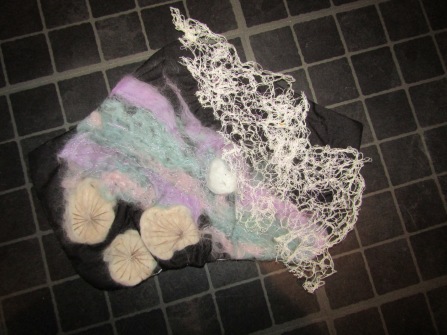 The second sample involved the black poly-cotton and pastel ‘fungi’. I decided to remove one portion of the fungi and essentially flip over the ‘lace’ into the space left before free-motion stitching that down whilst also adding stitching to the central felted panel. A fellow student felt this new sample was reminiscent of a sea theme with the lace being either sea foam or weeds washed up, (I also feel it could be fishing net in retrospect), with the remaining fungi being reminiscent of sea shells and hence the gathers could be seen to represent the rucks and movement of the sand. I decided to gather the bottom edge to add a further simple textural element and also backed the sample with a hand-dyed blue-pink soft cotton fabric (this is a bit of up-cycling as the fabrics was originally a bed sheet). When stitching the backing to the fabric I was very conscious not to catch the ‘lace’ as I wanted this to go beyond the edges – it blurs the edging on one side and draws the eye towards the other elements.
The second sample involved the black poly-cotton and pastel ‘fungi’. I decided to remove one portion of the fungi and essentially flip over the ‘lace’ into the space left before free-motion stitching that down whilst also adding stitching to the central felted panel. A fellow student felt this new sample was reminiscent of a sea theme with the lace being either sea foam or weeds washed up, (I also feel it could be fishing net in retrospect), with the remaining fungi being reminiscent of sea shells and hence the gathers could be seen to represent the rucks and movement of the sand. I decided to gather the bottom edge to add a further simple textural element and also backed the sample with a hand-dyed blue-pink soft cotton fabric (this is a bit of up-cycling as the fabrics was originally a bed sheet). When stitching the backing to the fabric I was very conscious not to catch the ‘lace’ as I wanted this to go beyond the edges – it blurs the edging on one side and draws the eye towards the other elements.


